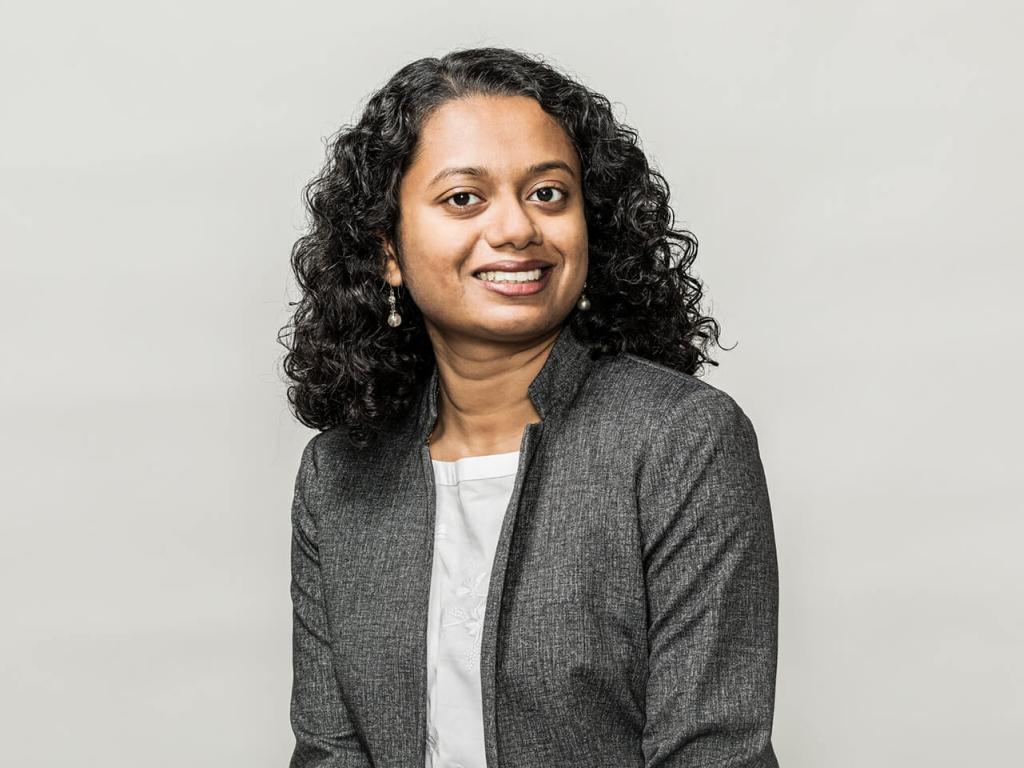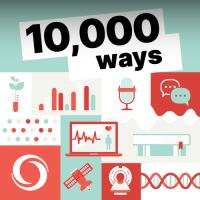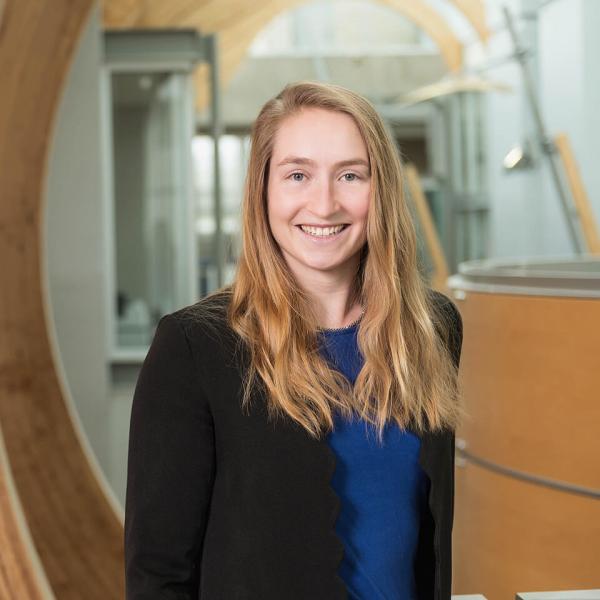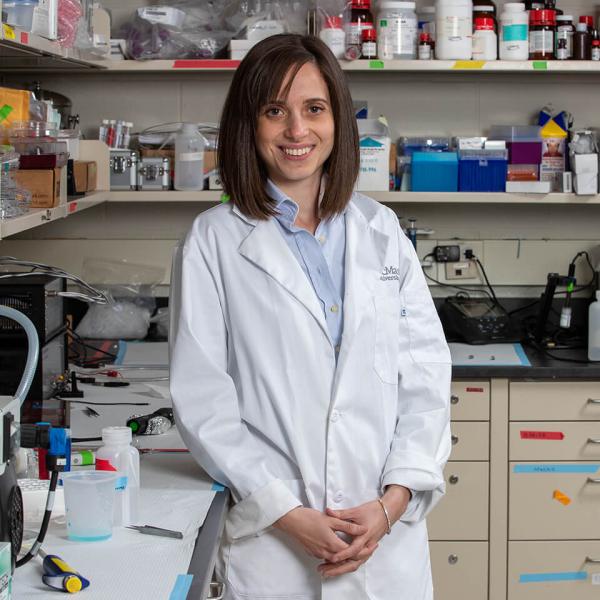Host:
This is a Canada Foundation for Innovation podcast.
(Music in)
Hello and welcome to 10,000 ways. This is a podcast about curious researchers, leading-edge science, and the joys of discovery.
Our podcast gets its name from Thomas Edison who said, “I have not failed. I’ve successfully found 10,000 ways that will not work.”
(Music out)
Pirathayini Srikantha:
My name is Pirathayini Srikantha. I completed my undergraduate degree in systems design engineering from the university of Waterloo, Master's degree from Electrical and Computer Engineering from the same institution and doctoral degree from the University of Toronto.
I hold a professional engineering license in the province of Ontario. I work at how we can make sure that we have electricity all the time when we need it and this electricity comes from clean energy sources.
Host:
Pirathayini Srikantha has numerous credentials to her name but one she didn’t mention was her Canada Research Chair in Reliable and Secure Power Grid Systems. The research chair program is designed to attract and retain top Canadian researchers.
Pirathayini’s work aims to enhance the reliability of our functional — but aging — electrical grids in order to accommodate all the various renewable energy sources that are starting to come online while at the same time, she’s trying to discourage hackers as the grid becomes more open and more connected to the internet of things.
What then is a power grid?
(Music in)
Srikantha:
The power grid is a highly complex organism. It’s a huge entity. It’s alive and changing. So basically, the power supply must meet the demands at every time step while ensuring that the infrastructure limits are heeded.
So, this requires a significant amount of planning, scaling from days to seconds to milliseconds to keep the grid going.
If there are last minute changes like an outage in generation sources or a spike in demands or outage of lines, losses in lines, the engineers must be able to overcome those issues and make sure that the system is running so that means that we need sufficient redundancies and backup in the system to make sure that the grid keeps on running all the time.
(Music out)
In terms of urban areas, we have above the ground cables that you see, distribution lines that you can see when you drive down your street or you can see these large transmission towers on the hydro corridors.
So, transmission networks transmit power over large distances at high voltages and in our streets, we see overhead lines, the small single lines, and poletop transformers. Those carry power at lower voltages and underground cables are there that we cannot see.
So, all of that work together to provide us with power without interruption.
Host:
Why should we care about the grid? It’s there. It works. What’s the risk? Some would even say, “If it ain’t broke, don’t fix it.”
Srikantha:
I don't know if we can imagine our lives without electricity because, many of our day to day activities depend on electricity right? So starting from the beginning, you turn on the lights, you turn on your stove if it’s an electric stove. You turn on the microwave. You use your phone. Everything depends on electricity. Our day-to-day mundane activities.
(Music in)
Also, one thing we have to keep in mind is that the infrastructure is old, the core infrastructure is very old, it's decades old and to replace all of that requires billions of dollars, and that's not going to happen.
So how do we, use control systems, control algorithms, optimization, artificial intelligence to overcome these infrastructural limitations and do smart scheduling and smart, you know, optimization to integrate as many renewables as possible while being, you know, while being aware of the limitations of the grid?
(Music out)
Host:
To ensure an uninterrupted flow of power, various systems need to talk to one another through access points known as “open protocols.” Many years ago, there was a limited number of power generation players. They would all use their own propriety systems of communication and control. How we generate electricity is evolving, however, we still have to accommodate a wide variety of renewable energy sources that are now coming online.
All of them will need to be integrated into the existing grid and these varying suppliers will require a common language and common access points. An evolving network is essential,
(Music in)
but there are definite hazards associated with open protocols.
Srikantha:
The modern grid is being integrated with sensors and the protocols are open now because it used to be proprietary back in the days where every unit would develop their own communication protocols.
But now all the protocols being open, communication systems are more accessible. It's available to many end points like consumers, like smart fridge, smart washing machine, smart meters and these protocols are susceptible to vulnerabilities.
It's more important now because communication capabilities are ubiquitous in the power grid.
So these open verticals have existing vulnerabilities that can be exploited by adversaries to eavesdrop.
So, if you are able to strategically place, place some eavesdroppers across the system, typically encryption is not used right, because it has a significant amount of overhead. So, if someone is able to eavesdrop, they will be able to perpetrate attacks on the power grid.
I think cybersecurity is a very important topic right now, especially for the power grid because it is a critical infrastructure
(Music out)
Host:
The grid is becoming an incredibly dynamic organism. Solar and wind are renewable energy sources that typically offer a reduced carbon footprint. That’s great for the environment but difficult to predict when the sun will shine, or the wind will blow.
It’s also not easy to predict when natural disasters will affect transmission or when drivers are going to charge their cars. Somehow, we have try and figure out how to incorporate all of these unpredictable variables and that’s what Pirathayini is trying to do.
(Music in)
Srikantha:
So if you look at the current grid, we are integrating a lot of the variable power devices like renewable generation, electric vehicles that can draw significant amount of power depending on how they are mobile and moving around.
And we may have batteries in our homes, and we can draw power from the grid to charge our batteries and inject power to the grid from our solar panels on the rooftop. So all of these are variable and power consumption is no longer that predictable right now. And uncertainty can push the grid to operate close to its limits.
And so any small event that can happen may result in cascading failures. So that's why the infrastructure that we have is at its limits. So how can we, you know, safeguard the system when we have such variability? And it will increase as the time goes. And also environmental conditions spurred by maybe climate change, like heavy rains, heavy thunderstorm, lots of snow, all of that can have an effect on, the power lines and the equipment.
(Music out)
Host:
With wildfires raging and temperatures soaring it’s getting harder to ignore the global impact of climate change. It’s very easy to feel overwhelmed. Pirathayini, however, has reason for optimism.
(Music in)
Srikantha:
We have ambitious goals as a country, for example, we have a net zero carbon emissions by 2035. So this means that, you know, we'll be engaging in more cleaner sources and that will hopefully help with the overall, effects of climate change, at least from the electricity sector.
Climate change is a real issue. I know it sounds like a cliche, like, for example, in Ontario, we are mostly powered by nuclear. Right? That's our clean source and that's going to be decommissioned soon. So, what's our ultimate right now? Because everything is being electrified, transportation sector, everything is relying on the grid to provide clean power.
So what's the alternative for nuclear plants? Right. I mean, it's a real immediate question and what's the point of having electrification when we if you are continuing to use carbon sources. California maybe like, you know, there's a lot of solar power, but in Ontario, that's not the case
So how do we overcome that? But there is battery, you know, solutions. But those are also associated with issues like, the full lifecycle of a battery. We don't know how it is, like the chemicals, the processes used to manufacture these devices, how are they disposed? Are they safe for the environment?
So, for me, what keeps me going is like the interesting challenges that need to be addressed immediately. So the immediate nature of that and the tools that we have in our disposal that I believe will allow us to achieve these lofty goals in time. So I think I can make a serious change with the work that I do.
(Music out)
Host:
Pirathayini sounds very self-assured in her abilities. She’s confident and has remained curious. These characteristics, however, weren’t generated overnight. So, we asked the question, who flicked the switch, so many years ago, to her power grid passion?
Srikantha:
I think it's my dad. He was an engineer, so he retired last week. We traveled a lot for his work. So I lived in Bahrain, I lived in Singapore, I lived in London just for his work and it seemed very important what he was doing. So, it was very intriguing.
He'd be on the phone all day talking about how to troubleshoot issues like you ping this you ping that. And I was just a little, you know, curious, that is it's also cool, you know, he looks like he's doing something important.
So I guess that sort of sort of triggered the interest and I did enjoy the subjects and you know what engineering entailed at that time.
I think I was like in the generation where, you know, like at least in our culture, like people around you don't encourage engineering to like women and females and so I just like to be more defiant and, you know, why not? I can do it! (Laughter)
Host:
If we’re lucky, a parent isn’t our only guide. Perhaps you can remember an especially empathetic tutor or an influential coach. Both of these titles should represent individuals who have willingly imparted their wisdom. Pirathayini has been one such recipient and she was fortunate enough to have two noteworthy mentors who she remembers with fondness.
(Music in)
Srikantha:
My advisor, my doctoral advisor, Deepa Kundur, like she's an incredible mentor she’s a female role model and my advisor for my master's degree Catherine Rosenberg. They are very strong women and they're very focused and they don't let anything bring them down. I admire that because I think that's something that I learned from them.
I've developed my drive from them, mainly Catherine Rosenberg because she's not forgiving. She is very no nonsense and she planted the value of theory and practical that both are equally important. She really, encouraged me to go out of my comfort zone and take courses and learn things that are, you know, not new to me and not in my field.
And she also introduced me to this area of smart grids. She said this is a new and upcoming topic. This was in 2010. That's when the whole, I think, movement really picked traction. Right. Climate change and smart grid.
So she said this area is new and upcoming and I think is very promising. Do you want to pursue it? I said I trust you, so I'll just go for it. Although I had no clue because power engineering was a bit scary, scary at the time, and my background, undergraduate background wasn't in that area. So for me to completely change fields, you know, was something that was a bit wary off, but I was confident because of my advisor.
So she's the one sort of made transformative changes, sort of like positions that help me make those decisions.
So I would say she's my role model.
(Music out)
Host:
In an earlier podcast, researcher Carla Prado talked about making a “leap of faith” when she moved from her native Brazil to study in Edmonton. Frequently, a hesitancy to make a profound change is based in part on a fear of failure. Many times, and in retrospect, one can never be really sure of the positive outcomes that can result from these fears and failures.
(Music in)
Srikantha:
For me, the way I take failure is, you know, it gives me more focus and allows me to be more refined right in the work that I do. So perhaps I might get even greater success, although after some delays. So for example, at the early stage of my career in the research area field, I've gotten several rejections from, you know, journals and conferences and that's mainly because I didn't know what they were expecting and how I should frame it…
And I think the feedback that I received from my peers although it was rejections I was able to really refine whatever I did.
I always think rejections and so called failures as a positive thing because I think we always learn from mistakes for future work and all my experiences have been shaped by some sort of failure.
I started my Masters in 2009 and then I switched to PhD directly from Masters. And then I received an NSERC post graduate scholarship for doctoral and then in one year I just didn't know what I was doing. So I, I just stopped with the master's degree. So I sort of quit and gave up my scholarship and I went back to the industry.
I worked for two years and that shaped my experience. I think I really realized that I wanted, you know, I was much more excited with research, and I went back. So, although there are losses there, there were some losses. I don't regret anything I did; I lost my scholarship. I lost my time.
But I think that experience really made me confident with my choice.
So in terms of research. I think we always learn from mistakes for future work and all my experiences have been shaped by some sort of failure so I guess it’s not a bad thing.
(Music out)
Host:
A 1971 study by psychologists Harry Harlow and Edward Deci found that the “carrot and stick” reward philosophy can actually impair motivation. This anti-motivational philosophy is known as extrinsic motivation. Intrinsic motivation, however, comes from within. It’s an internally driven motivation generated in part by being given the freedom to do enjoyable tasks with commitment and passion.
Srikantha:
So when you get to a point where you're doing the same thing again and again and the same research problem, but you're using the same technique to solve different things, it just gets, a bit boring and repetitive. And I want to stay away from that.
For me, it's always I'm looking for ways to learn. I guess I have an intrinsic need to learn new things and that's what keeps me excited because when I was young, I was excited to smell books, for example, like it's I am a weird person, in that sense and I would love to read textbooks.
I would do it every single problem because I just like it so I have an interesting need to learn and that's why I think I am happy in my field because, you know, you can't solve these things without going out of your comfort zone and learning new things. So I guess that, the reason why I'm happy is because, you know, there's always infinite ways of things to learn.
Like, even like I just I just have a drop of knowledge, I would say, at this point and there's so much more to to learn and experience. So I think that's that's what that gives me excited.
Host:
Pirathayini talks about her drop of knowledge. A drop may not sound like very much but eventually enough drops will fill a bucket.
Pirathayini recognizes that climate change is a complex equation and within her domain, exceptional teamwork is going to be required to find solutions. She remains optimistic, however, in the abilities of herself and her colleagues to solve these upcoming challenges, where the sum of the solutions will be greater than the individual drops.
(Music in)
Srikanta:
It's a huge puzzle that we're trying to solve and so enabling a zero carbon footprint or zero emissions. It's a connection of many, many processes and many, many advances. Right?
And it's not just one piece, but I think my work will have a significant impact in at least systems level optimization and coordination. Right? So that's a critical piece to ensuring that everything works well together. So it's part of like it's not just my part, it's just a functioning of many, many things that should function together
I think it's very optimistic to see regulatory bodies impose these, ambitious goals about, you know, for zero emissions by 2035.
Everyone has to play a part in this climate change initiative and as an individual, the way I use power, the way I select, how I travel to work, the way I function, those are decisions I can make to contribute to reducing the impacts at a larger scale because, you know, actions in large scale can make a huge difference and I think every individual has the power to do that.
(Music out)
Host:
A spark of interest can become manifest even at a very young age. Little did Pirathayini’s father know that as his daughter sat on the stairs quietly listening to his conversations, a switch would flick which would ultimately light the path, on her way to also becoming an engineer. Remarkably, history may be repeating itself with Pirathayini and her daughter.
(Music in)
Srikantha:
I have a daughter, she's three years old.
She loves puzzles. I started off by just putting it together and I asked her, can you help me press it? And then she started just putting it together and she just was very curious, like she wants to take it apart. For example, we have a Roomba with a bucket. So she's trying to figure out you know, all sorts of quality assurance, you know, practical things.
And surprisingly, she's not interested in conventional toys, which I guess all children are different, but she's more interested in what adults are doing, what we are doing and she has to be part of it and we encourage it.
And I think, you know, just exposing her to these kind of engineering related toys and things that she's excited. So you need to expose them at a younger age and that's where a change happens from the beginning. From the root.
(Music out)
Host:
While the age of three might be a little young to start contemplating a career in the green economy, you’re not too young if you’re nearing the end of high school or you’ve just completed an undergraduate degree. There is a growing demand for “green talent.”
For example, if you searched “climate change jobs” you’ll find a national Canadian retailer looking for a “Manager of Sustainability and Climate Change Measurement and Reporting” and a global consultancy firm is looking for candidates versed in social and environmental sustainability. Pirathayini is excited about future opportunities in the green job sector.
Srikantha:
I think there's a serious need for personnel, because we’re experiencing, a lot of retirements coming up soon, the next few years. People are in the area of like the power sector, many, of the skilled professionals are retiring. And that's going to be a significant amount of need for skilled professions in the area of, you know, climate change and power systems.
And this is what I say to these students. You know, if you select this field, it's interdisciplinary, you’re combining everything, communications, AI, it's not just, you know, it’s not like one specific discipline.
So I think there's a room for a lot of impact and you can make a change, a difference, and the workforce needs you. So go into this field.
Host:
On June 12, 2005, the late Steve Jobs, founder of Apple and Pixar, gave a commencement address to the graduating class of Stanford University. This is what he had to say regarding work. “Your work is going to fill a large part of your life, and the only way to be truly satisfied is to do what you believe is great work.
(Music in)
And the only way to do great work is to love what you do.”
Srikantha:
Just working with, the cutting edge. You're the cutting edge at the forefront… right... of technologies. and just being at that cutting edge and being at that stage where, you know, you can influence many things in the field, it's just exciting and it makes me wake up every day, even though, you know, I have a toddler and, you know, sleep deprived, whatever, like I'm able to function as it is because I'm excited, right? I'm excited about the problems that I work with.
I'm excited about the people that I work with. I'm excited by the results we have. You have to be fundamentally excited and I am. (Laughter)
Host:
10,000 ways is produced in the studios of the Canada Foundation for Innovation. The CFI is a non-profit corporation that invests in research infrastructure at Canadian universities, colleges, research hospitals and non-profit research institutions. To date, we’ve funded almost 13,000 projects and contributed over 10 billion dollars in research infrastructure funding.
If you’re curious to learn more about the CFI, then please visit innovation.ca. That’s i n n o v a t i o n dot c a.
My name is Greg Pilsworth and thank you very much for listening. Bye bye.
(Music out)






